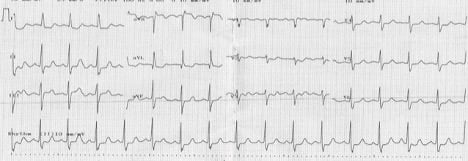It’s a Friday at 4:30 pm, and your patient says the classic “Oh by the way…”, followed by a chief complaint of left shoulder pain. He was 78 y/o male who walked with a cane and had known DJD. But, he also had known CAD. In fact, he had multiple stents. And his most recent stent was one month ago.
It is so tempting to write off extremity pain to arthritis. And, since he just had a stent, he should be fine, right?
So, you order an EKG just to be sure. And for a minute, you are reassured that there is no STEMI…but look at his EKG a little closer.
It showed widespread ST depression and more than 1 mm of ST elevation in AVR. This is a constellation that is classic for high-grade LAD occlusion. But is this even possible for him to have a new lesion that fast? Or did his previous stent reocclude?
It is possible, but in his case, his previous stent was in his right coronary artery. And so he had a new culprit lesion!
This will usually be read by the machine as non-specific st changes. This is a read that should ALWAYS make you worry. So many of the most lethal findings are read as non-specific.
In this case, consultation with the cardiologist led to him going to the cath lab, and his angiogram showed that he had a proximal high-grade lesion of his LAD, which was stented, and he did well post-procedure. His shoulder pain completely resolved.
In some cases, you can see this same finding when a patient is tachycardic. But when you see this in someone who is not tachycardic, you should be highly suspicious.

